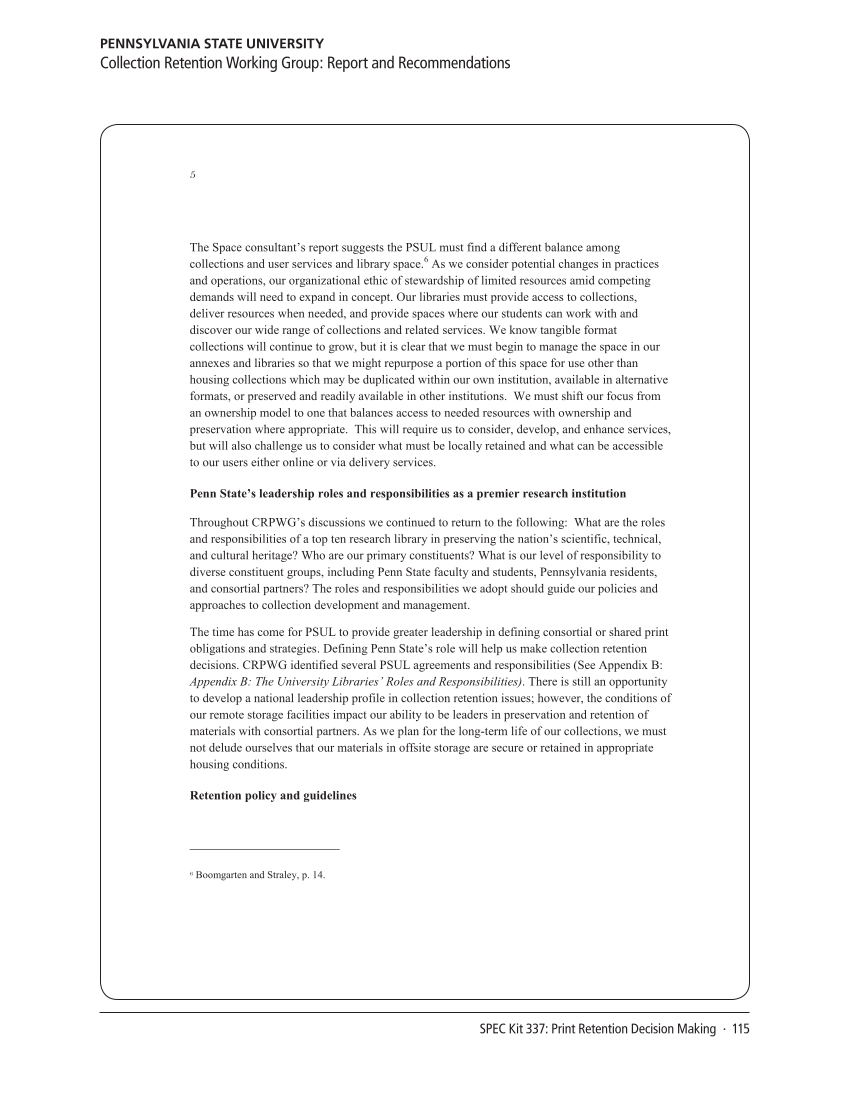SPEC Kit 337: Print Retention Decision Making · 115
PENNSYLVANIA STATE UNIVERSITY
Collection Retention Working Group: Report and Recommendations
5
The Space consultant’s report suggests the PSUL must find a different balance among
collections and user services and library space.6 As we consider potential changes in practices
and operations, our organizational ethic of stewardship of limited resources amid competing
demands will need to expand in concept. Our libraries must provide access to collections,
deliver resources when needed, and provide spaces where our students can work with and
discover our wide range of collections and related services. We know tangible format
collections will continue to grow, but it is clear that we must begin to manage the space in our
annexes and libraries so that we might repurpose a portion of this space for use other than
housing collections which may be duplicated within our own institution, available in alternative
formats, or preserved and readily available in other institutions. We must shift our focus from
an ownership model to one that balances access to needed resources with ownership and
preservation where appropriate. This will require us to consider, develop, and enhance services,
but will also challenge us to consider what must be locally retained and what can be accessible
to our users either online or via delivery services.
Penn State’s leadership roles and responsibilities as a premier research institution
Throughout CRPWG’s discussions we continued to return to the following: What are the roles
and responsibilities of a top ten research library in preserving the nation’s scientific, technical,
and cultural heritage? Who are our primary constituents? What is our level of responsibility to
diverse constituent groups, including Penn State faculty and students, Pennsylvania residents,
and consortial partners? The roles and responsibilities we adopt should guide our policies and
approaches to collection development and management.
The time has come for PSUL to provide greater leadership in defining consortial or shared print
obligations and strategies. Defining Penn State’s role will help us make collection retention
decisions. CRPWG identified several PSUL agreements and responsibilities (See Appendix B:
Appendix B: The University Libraries’ Roles and Responsibilities). There is still an opportunity
to develop a national leadership profile in collection retention issues however, the conditions of
our remote storage facilities impact our ability to be leaders in preservation and retention of
materials with consortial partners. As we plan for the long-term life of our collections, we must
not delude ourselves that our materials in offsite storage are secure or retained in appropriate
housing conditions.
Retention policy and guidelines
6 Boomgarten and Straley, p. 14.
PENNSYLVANIA STATE UNIVERSITY
Collection Retention Working Group: Report and Recommendations
5
The Space consultant’s report suggests the PSUL must find a different balance among
collections and user services and library space.6 As we consider potential changes in practices
and operations, our organizational ethic of stewardship of limited resources amid competing
demands will need to expand in concept. Our libraries must provide access to collections,
deliver resources when needed, and provide spaces where our students can work with and
discover our wide range of collections and related services. We know tangible format
collections will continue to grow, but it is clear that we must begin to manage the space in our
annexes and libraries so that we might repurpose a portion of this space for use other than
housing collections which may be duplicated within our own institution, available in alternative
formats, or preserved and readily available in other institutions. We must shift our focus from
an ownership model to one that balances access to needed resources with ownership and
preservation where appropriate. This will require us to consider, develop, and enhance services,
but will also challenge us to consider what must be locally retained and what can be accessible
to our users either online or via delivery services.
Penn State’s leadership roles and responsibilities as a premier research institution
Throughout CRPWG’s discussions we continued to return to the following: What are the roles
and responsibilities of a top ten research library in preserving the nation’s scientific, technical,
and cultural heritage? Who are our primary constituents? What is our level of responsibility to
diverse constituent groups, including Penn State faculty and students, Pennsylvania residents,
and consortial partners? The roles and responsibilities we adopt should guide our policies and
approaches to collection development and management.
The time has come for PSUL to provide greater leadership in defining consortial or shared print
obligations and strategies. Defining Penn State’s role will help us make collection retention
decisions. CRPWG identified several PSUL agreements and responsibilities (See Appendix B:
Appendix B: The University Libraries’ Roles and Responsibilities). There is still an opportunity
to develop a national leadership profile in collection retention issues however, the conditions of
our remote storage facilities impact our ability to be leaders in preservation and retention of
materials with consortial partners. As we plan for the long-term life of our collections, we must
not delude ourselves that our materials in offsite storage are secure or retained in appropriate
housing conditions.
Retention policy and guidelines
6 Boomgarten and Straley, p. 14.


















































































































































































































